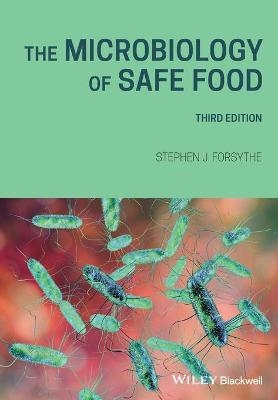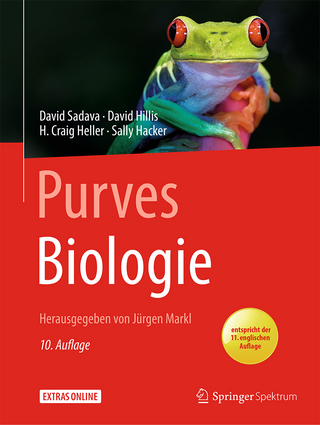
The Microbiology of Safe Food
Wiley-Blackwell (Verlag)
978-1-119-40501-6 (ISBN)
As our methods of food production advance, so too does the need for a fuller understanding of food microbiology and the critical ways in which it influences food safety. The Microbiology of Safe Food satisfies this need, exploring the processes and effects of food microbiology with a detailed, practical approach. Examining both food pathogens and spoilage organisms, microbiologist Stephen J. Forsythe covers topics ranging from hygiene regulations and product testing to microbiological criteria and sampling plans.
This third edition has been thoroughly revised to cater to the food scientists and manufacturers of today, addressing such new areas as:
Advances in genomic analysis techniques for key organisms, including E. coli, Salmonella, and L. monocytogenes
Emerging information on high-throughput sequencing and genomic epidemiology based on genomic analysis of isolates
Recent work on investigations into foodborne infection outbreaks, demonstrating the public health costs of unsafe food production
Updates to the national and international surveillance systems, including social media
Safe food for consumers is the ultimate goal of food microbiology. To that end, The Microbiology of Safe Food focuses on the real-world applications of the latest science, making it an essential companion for all those studying and working in food safety.
STEPHEN J. FORSYTHE is former Professor of Microbiology at Nottingham Trent University, Nottingham, UK. He is currently Visiting Professor to many universities and sits on a number of governmental advisory committees. He has many years of experience teaching food microbiology to university students and professionals within the food industry and government regulatory bodies.
Preface to third edition xvii
Preface to second edition xix
Preface to first edition xxi
1 Foodborne infections 1
1.1 The microbial world and its relationship to food 2
1.2 Origins of safe food production 6
1.3 Overview of foodborne illness 7
1.4 Public perception of safe food 14
1.5 Causes of foodborne illness 17
1.6 Food poisoning due to common food commodities 20
1.7 Host‐related issues 22
1.8 Hygiene hypothesis 23
1.9 Chronic sequelae following foodborne illness 23
1.10 The size of the foodborne illness problem 24
1.11 The cost of foodborne diseases 36
1.12 Changes in antimicrobial resistance of foodborne pathogens 38
1.13 Food safety following natural disasters, and conflict 42
1.14 Food microbiology, foodborne diseases and climate change 43
2 Basic aspects 45
2.1 The human intestinal tract 45
2.2 The normal human intestinal flora 46
2.3 Host resistance to foodborne infections 51
2.4 Bacterial cell structure 52
2.5 Bacterial toxins and other virulence determinants 55
2.6 Microbial growth cycle 63
2.7 Death kinetics 63
2.8 Factors affecting microbial growth 68
2.9 Microbial response to stress 73
2.10 Predictive modelling 78
3 Food preservation and spoilage organisms 85
3.1 Spoilage micro‐organisms 85
3.2 Shelf life indicators 91
3.3 Methods of preservation and shelf life extension 93
3.4 Preservatives 95
3.5 Physical methods of preservation 100
3.6 Packaging 109
3.7 Fermented food products 111
3.8 Organisms involved in the production of fermented foods 118
3.9 Functional foods: probiotics and gut modulation 128
4 Bacterial foodborne pathogens 135
4.1 Indicator organisms 137
4.2 Campylobacter jejuni, C. coli and C. lari 139
4.3 Salmonella serovars 148
4.4 Pathogenic E. coli 160
4.5 Sh. dysenteriae and Sh. sonnei 176
4.6 Cronobacter species 178
4.7 Vibrio cholerae, V. parahaemolyticus and V. vulnificus 184
4.8 Brucella melitensis, Br. abortus and Br. suis 188
4.9 Yersinia enterocolitica 189
4.10 Aeromonas hydrophila, A. caviae and A. sobria 191
4.11 Plesiomonas shigelloides 193
4.12 Listeria monocytogenes 194
4.13 Staphylococcus aureus 207
4.14 Clostridium perfringens 210
4.15 Clostridium botulinum 211
4.16 B. cereus group 213
4.17 Enterococcus and Streptococcus species 217
4.18 Emerging and uncommon foodborne pathogens 219
5 Foodborne pathogens: viruses, toxins, parasites and prions 233
5.1 Foodborne viruses 233
5.2 Seafood and shellfish poisoning 244
5.3 Foodborne parasites: eucaryotes 248
5.4 Mycotoxins 253
6 Methods of detection and characterisation 259
6.1 Prologue 259
6.2 Conventional methods 264
6.3 Rapid sampling methods 269
6.4 Rapid end‐detection methods 273
6.5 DNA‐based molecular typing and proteomic methods 279
6.6 Identification and typing methods based on high‐throughput DNA sequencing 288
6.7 Specific detection procedures and accreditation 292
7 Microbiological criteria 313
7.1 Background to microbiological criteria and end‐product testing 313
7.2 International commission on microbiological specifications for foods (ICMSF) 313
7.3 Codex Alimentarius principles for the establishment and application of microbiological criteria 314
7.4 Sampling plans 316
7.5 Variables plans 318
7.6 Attributes sampling plan 321
7.7 Principles 322
7.8 Microbiological limits 329
7.9 Implemented microbiological criteria 333
7.10 UK guidelines for ready‐to‐eat foods 333
8 Hygienic production practices 337
8.1 Contribution of food handlers to foodborne illness 337
8.2 Personnel hygiene and training 337
8.3 Cleaning 340
8.4 Detergents and disinfectants 343
8.5 Microbial biofilms 343
8.6 Assessment of cleaning and disinfection efficiency 348
9 Food safety management tools 351
9.1 The manufacture of hygienic food 351
9.2 Microbiological safety of food in world trade 357
9.3 Consumer pressure effect on food processing 358
9.4 The management of hazards in food in international trade 359
9.5 Hazard analysis critical control point (HACCP) 359
9.6 Prerequisite programme 360
9.7 Outline of HACCP 363
9.8 Microbiological criteria and HACCP 367
9.9 Microbiological hazards and their control 369
9.10 HACCP plans 371
9.11 GMP and GHP 382
9.12 Quality systems 382
9.13 Total quality management 382
10 Microbiological risk assessment 385
10.1 Risk analysis and microbiological risk assessment 385
10.2 Origin of MRA 387
10.3 MRA – an overview 389
10.4 MRA – structure 392
10.5 Risk assessment 395
10.6 Risk management 415
10.7 Food safety objectives (FSO) 419
10.8 Risk communication 421
10.9 Future developments in MRA 422
11 Application of microbiological risk assessment 425
11.1 Salmonella serovars 425
11.2 Campylobacter 435
11.3 L. monocytogenes 442
11.4 E. coli O157 449
11.5 Bacillus cereus 451
11.6 Vibrio parahaemolyticus 453
11.7 Cronobacter species and Salmonella in powdered infant formula (PIF) 455
11.8 Viral risk assessments 457
12 International control of microbiological hazards in foods: regulations and authorities 459
12.1 Control of foodborne pathogens 459
12.2 World Health Organisation (WHO), global food security from accidental and deliberate contamination 464
12.3 Regulations in international trade of food 467
12.4 Codex Alimentarius Commission (CAC) 468
12.5 SPS measures, Technical Barriers to Trade (TBT) and the WHO 469
12.6 EU legislation 470
12.7 International food safety agencies 471
13 Surveillance and foodborne outbreak investigation 475
13.1 Surveillance programmes 475
13.2 Outbreak investigations 483
13.3 Social media, crowd sourcing and reporting food poisoning cases 492
13.4 Mobile phones and food safety 493
13.5 Food terrorism and biocrimes 493
14 Whole‐genome sequencing, microbiomes and genomic epidemiology 499
14.1 High‐throughput DNA sequencing 499
14.2 Microbiome analysis 501
14.3 Genomic epidemiology 503
14.4 Key outbreaks investigated using genomic epidemiology 505
Glossary of terms 515
List of abbreviations 521
Food safety resources on the world wide web 525
Plates and credits 531
References 533
Index 563
| Erscheinungsdatum | 19.08.2019 |
|---|---|
| Verlagsort | Hoboken |
| Sprache | englisch |
| Maße | 168 x 239 mm |
| Gewicht | 1089 g |
| Themenwelt | Naturwissenschaften ► Biologie |
| Technik | |
| ISBN-10 | 1-119-40501-7 / 1119405017 |
| ISBN-13 | 978-1-119-40501-6 / 9781119405016 |
| Zustand | Neuware |
| Informationen gemäß Produktsicherheitsverordnung (GPSR) | |
| Haben Sie eine Frage zum Produkt? |
aus dem Bereich


